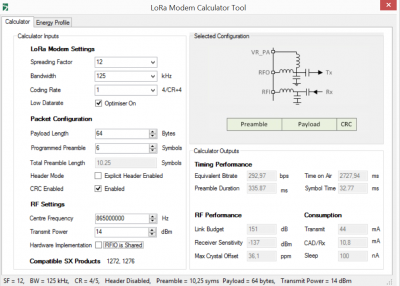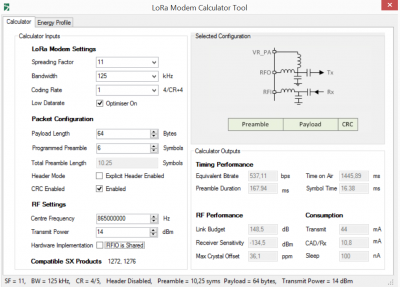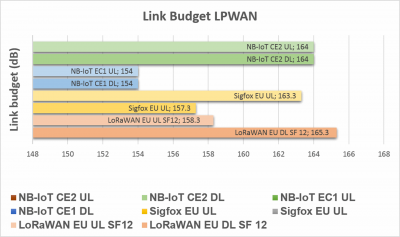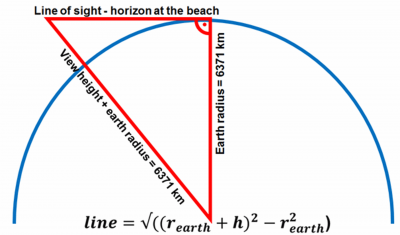There are many places where you can repeatedly read about the mystical range of 15 km at LPWAN. A manufacturer of LPWAN radio transceivers even advertises with 15 miles to 30 miles on its homepage, which would be 24 km to 48 km. Why not 700 km or 4300 km?
None of the range specifications for LPWAN of 15, 24 or 48 km refer to any mathematical or physical basis for calculation. Therefore some physical boundary conditions have to be named. In addition to the maximum transmission power, the sensitivity of the receiver, the transmission frequency and the height of the two antennas are all factors that dictate the range.
The maximum transmission power for radio IoT devices in Europe in the license-free 868 MHz band is +14 dBm ERP. The sensitivity of the radio transceivers is named differently by the manufacturers and radio protocols. The Link Budget (already explained here) results from the radiated power minus the sensitivity of the receiver and minus all losses.
A higher data rate with a radio is always at the cost the sensitivity. The graph illustrates that if the data rate for LoRa changes from 297 bit/s to 537 bit/s, the sensitivity decreases by 2.5 dB.
For the range calculation, the lower data rate of 292 bit/s with a sensitivity of -134 dBm in the node and -137 dBm in the gateway is used for LoRaWAN for the present. The link budget is formed from the delta of the maximum transmission power and the sensitivity and thus results in a link budget of 158 dB in the upload. Please note the 5.15 dBi gain, which only applies to LoRaWAN and Sigfox in receive mode. Antenna gain in the antenna must be reduced at the gateway by reducing the transmission power. The table is idealized. In receive mode, a loss of one to three dB is generated in the connectors and cables between the antenna and the gateway. These losses are not considered in the table.
| LoRa-WAN EU DL SF 12 | LoRa-WAN EU UL SF12 | Sigfox EU UL | Sigfox EU UL | NB-IoT CE1 DL | NB-IoT EC1 UL | NB-IoT CE2 DL | NB-IoT CE2 UL | |
| TX max ERP (dBm) | 27 | 14 | 27 | 14 | ||||
| Gain TX antenna | 0 | 0 | 0 | 0 | ||||
| Delta to ERPi 2.15 dBi | 2.15 | 2.15 | 2.15 | 2.15 | ||||
| RX Sensitivity (neative value in dBm) | 134 | 137 | 126 | 142 | ||||
| Gain of RX antenna (dbi) | 2.15 | 5.15 | 2.15 | 5.15 | ||||
| Link budget (dB) | 165.3 | 158.3 | 157.3 | 163.3 | 154 | 154 | 164 | 164 |
The table and graph illustrate the asymmetry of the link budget at Sigfox and LoRaWAN. In the further considerations we set the link budget to 154 dB. 154 dB Link Budget applies to NB-IoT CL1. The loss through fading and attenuation in the wall of the building we set to 28 dB. Link budget and losses finally determine the range of an LPWAN. For LPWAN planning, everyone must then use own assumed values.
Free space attenuation in space
In the first approach, space is assumed to be the environment, where the formula for Free Space Path Loss (FSPL) applies:
c = speed of light
f = Frequency
r = Radius
| Link budget | 154 dB | 157 dB | 164 dB |
| Range with 868 MHz | 1380 km | 1950 km | 4355 km |
As a great surprise, with a link budget of 154 dB, this formula does not provide a range of 15 km, but 1380 km. With 3 dB more the range already increases to 1950 km and 10 dB more the range in space increases to 4355 km. In space, the radio signals travel much further. But now back to the ground of facts, to a beach with a view over the sea to the horizon.
Line of sight to the horizon at the beach
At 1.7 m eye level it is possible to look 4.7 km far on the beach. The reason for this was already discovered hundreds of years ago by Nikolaus Kopernikus. The earth is not a disk, but an ellipsoid with an average radius of 6371 km. The problem is also known in sailing. Those who obtain a sailing license have to consider the range of light. The sight can be calculated according to the following equation:
In total, the observer must stand on a 16 m high platform at 1.7 m eye level in order to be able to observe the 15 km distance mentioned at the beginning, in order to achieve the eye height of 17.7 m.
Mobile radio base stations (LTE) are planned at a height of approx. 20 m in the urban area. At 20 m eye level, 19.6 km across the sea to the horizon can already be seen on the beach.
| Eye level at the beach [m] | Line of sight [km] |
| 1,7 | 4,7 |
| 17,7 | 15,0 |
| 20,0 | 19,6 |
However, the horizon is only one of the limitations of a radio wave. The quasi-optical propagation on the beach applies to radio waves in the sub-GHz range and not on the land surface. In the next step, the wave propagation is therefore considered with the Hata-Okumura model (Hata model in short).
Hata-Okumura model
The Hata model uses different terms in the attenuation formula to differentiate between land use – from undeveloped areas to urban density.
with:
d = distance between transmitter and receiver
hS = height of the transmitter antenna at the base station
hR = Receiver antenna height
K = constant for type of city and buildings
Undeveloped: K = 4.78 ×(log(f2) – log(f) + 40.94
Suburban: K = 2 × log(f/28)2 + 5,4
Small town: K = (1,1 × log(f) – 0,7) × hR – (1,56 × log(f) – 0,8)
Large city, f < 300 MHz: K = 8.29 × (log(1.54 × hR))2 – 1.1
Large city, f > 300 MHz: K = 3,2 × (log(11,7555 × hR))2 – 4,97
f = transmission frequency
For the following range analysis, an attenuation of 20 dB is assumed for building penetration and a loss of 8 dB for fading. This means that it can be adapted to the conditions for remote reading of energy meters – one of the important target markets for LPWAN. In Germany, meters are generally installed in buildings. The link budget is therefore reduced by 28 dB for all LPWAN technologies to compare the coverage in densely built-up environments.
| LoRaWAN
EU SF 11 DL |
LoRaWAN
EU SF 12 DL |
Sigfox EU | NB-IoT CL 1 | NB-IoT CL 2 | LTE-M | |
| Link Budget | 155,5 | 158 | 157 | 154 | 164 | 157 |
| Range Hata Open (km) | 38.8 | 45.7 | 42.7 | 35.2 | 67 | 42.7 |
| Range Hata City(km) | 5.74 | 6.77 | 6.75 | 5.2 | 9.9 | 6.75 |
| Range City with 28 dB loss (km) | 0.943 | 1.11 | 1.04 | 0.85 | 1.63 | 1.04 |
| Line of sight (km) | 22.7 | 22.7 | 22.7 | 22.7 | 22.7 | 22.7 |
Calculation of the range and coverage of LPWAN base stations according to the Hata-Okumura model.
Band 20 is below 868 MHz and band 8 is above. To simplify the consideration we set the transmission frequency at NB-IoT to 868 MHz. The height of the antenna of the base station was chosen with 25 meters, because this is the usual antenna height of LTE antennas in urban areas in Germany. The height of the antenna systems in Germany can be found online in the database of the Federal Network Agency. The antenna height at the sensor was set to 1 m, because 1 m is the lowest limit according to the Hata model. The above table illustrates the differences between Hata Open, Hata City and Hata City with 28 dB losses through the first wall and fading. Hata open means that nothing stands in the path between the base station antenna and the sensor antenna. The radio wave is only attenuated by the already declared free space attenuation and the earth’s surface. The Hata model doesn’t know the curvature of the earth. Therefore, the ranges of 35-67 km in the table above are theoretical values. The line of sight limits our range to 22.7 km. The simple Hata model does not know the differences between water surfaces, meadows, farmland or open areas with little vegetation. The simulation software for the wave propagation with terrain model takes into account the differences of the attenuation of the soil procurement. The above table should only illustrate the differences in the range in open terrain, in building development and in the penetration of radio waves into buildings. The simulation software takes a part of the considerations for us later. However, more about simulation later.
In the formula given here, the range is determined by three parameters: the height of the transmitting antenna, the height of the receiving antenna and the transmitting frequency. The highest building in the middle of the state capital Hanover is owned by the utility company and has a height of 92 m. With a transmitting antenna mounted on this building, a range of only 93 km can be calculated according to Hata – if the building were to stand in a less built-up flat landscape and not in the middle of a big city. Unfortunately, the line of sight is against it. This limits us to 40 km. If 48 km range were to be achieved, the line of sight model would require the transmitting antenna to be installed on a 137 m high tower.
Towers and buildings at a height of 92 m or even 137 m are not only sparsely dotted in Lower Saxony. The world’ tallest building is currently the Burj Khalifa skyscraper in Dubai with a height of 828 metres. An LPWAN gateway on the skyscraper we will have a closer look at later. In flat land, in the absence of towers, buildings or mountains with the necessary height, ranges of 48 km with a link budget of 154 dB are difficult to realize.
Conclusion
The Hata model knows no earth curvature and is only a first approximation. As a counter check you should draw the line of sight. Simulation software knows the topography, earth curvature and buildings and often uses often the Longley-Rice model to determine the range. The simulation of LPWAN is discussed in further articles.
References:
- Link budget: https://en.wikipedia.org/wiki/Link_budget
- Radio Link Budget: details & formula https://www.electronics-notes.com/articles/antennas-propagation/propagation-overview/radio-link-budget-formula-calculator.php
- Free field damping and Hata Radio Propagation Online Tool: http://wwwpub.zih.tu-dresden.de/~guetter/candy/tools/candy-prop-outdoor.htm
- Line-of-Sight Online Tool: https://planetcalc.com/1198/
- Hata model https://en.wikipedia.org/wiki/Hata_model
Does this article gain your interest? Do you have a wireless IoT idea? Do you plan an IoT device with embedded antennas? Do you have an IoT prototype and have a need for optimisation or price? If your answer to any of these qustions is “YES”. Then do not hesitate to drop an email to harald.naumann (at) lte-modem.com and to ask for an akorIoT radio adapter or some engineering services to make your IoT idea reality.





1 Comment
Add a Comment